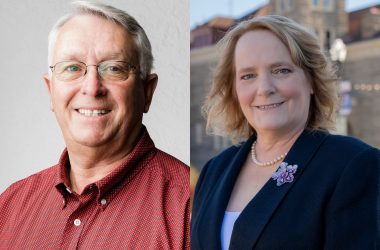 The ARCHES Project case worker Ken Houghton, left, and Bob Francis, a volunteer, walk to the homeless camp shortly before its eviction by the city of Salem in January. (Troy Brynelson/Salem Reporter)
The ARCHES Project case worker Ken Houghton, left, and Bob Francis, a volunteer, walk to the homeless camp shortly before its eviction by the city of Salem in January. (Troy Brynelson/Salem Reporter)
Nearly $100 million in public dollars was spent helping homeless in the region last year, according to a new report, and local leaders say they want to make that money count better.
“There’s so many resources dedicated to this problem and there’s so little coordination,” said Jimmy Jones, executive director of the Mid-Willamette Valley Community Action Agency. “The impact of this dollar is probably less here than in a similar-sized city because there is a lack of coordination and planning.”
The report is an update on the Mid-Willamette Valley Homeless Initiative that is slated to go before Salem City Council on Monday. The city is one of a handful of bodies working in the initiative to aid homeless.
Documents released Thursday included a “money map” tracing how governments, as well as organizations, spend money toward that goal. The money can originate from local funds or from various government grants.
The map was completed by the Homeless Initiative Program Coordinator, a position once held by Ali Treichel, who left late last year, and currently held by former Marion County Commissioner Janet Carlson.
The report found that roughly $49 million in total is spent on services like addiction treatment, jobs training, mental health outreach and more. Another $39 million pays for permanent housing.
The map did not draw any explicit conclusions, nor does it make any suggestions. Its goal is providing a high-altitude look at the region’s spending, Carlson said.
“The goal was to be able to show where all the money was coming from,” said Carlson. “If we’re better coordinated in the outcomes we’re trying to achieve, we would be more effective. That’s the hypothesis.”
Carlson said the map was completed last fall.
The map found that, among the 10 entities who use public money, Marion County spent $57 million last year, the city of Salem spent $24 million and Polk County spent $4.8 million.
Salem Mayor Chuck Bennett said the map helps clarify where the entities overlap.
“What the map really shows is the cities and counties in this region need to do a more coordinated program,” he said. “If you go through in some detail, you may find where there’s repetition of service, failures of service to apply, all of these sorts of things need to be addressed so you can create a coordinated program.”
The Mid-Willamatte Valley Community Action Agency spent $10.3 million and the Mid-Valley Behavioral Care Network spent $6.6 million. The Salem-Keizer School District gave $739,000; followed by smaller earmarks from the Central School District and the cities of Keizer, Independence and Monmouth.
SEE: The 2017-18 Money Map for Housing/Homeless Service Provision
According to the map, the Marion County Health Department alone accounted for $35.7 million. Its Intensive Services & Supports division spent $10.7 million to help people with especially complex issues, said Cydney Nestor, the county’s human resources director for the division.
“They might look like mental health (issues) combined with chronic medical conditions or substance abuse,” Nestor said of the division’s work. The issues are complex enough that the individuals require the care of entire teams, she said.
“A therapist you visit once a week isn’t enough,” she said of the cases. “These teams are made up of psychiatrists, therapists, people providing skills training.”
Salem Housing Authority was the biggest contributor to Salem’s efforts, spending $20.7 million in fiscal year 2016-17 with nearly $19 million used for housing assistance.
Salem’s Urban Development Department spent $2 million across 16 programs, ranging from a $550,000 grant to rehabilitate Yaquina Hall for affordable housing to another $120,000 to Northwest Human Services for a crisis hotline.
Urban Development Director Kristin Retherford said having all of the information laid out gives “a deeper understanding of the financial resources within our continuum of care and how they are allocated.”
“Moving forward, the map will be a helpful tool in identify services and areas that are more research rich, areas where there are funding gaps, and will help inform strategic decision making in the allocation of financial resources to address homelessness,” she said in an email.
Jones said he hasn’t seen many of these maps produced in other places, so it’s difficult to weigh the region’s nearly $100 million output to other places.
“These money maps aren’t commonly produced. Even a study of this level is sort of rare. Eugene probably has the same information, but I don’t know if it’s been presented in this same way,” he said.
Besides the money map, the report going before Salem City Council will also discuss panhandling ordinances used in other Oregon cities.
The council will also discuss possibility of teaming with local governments to form their own Continuum of Care – an entity that receives funds from the U.S. Department of Housing and Urban Development. Since 2011, the mid-Willamette Valley region has been apart of the Rural Oregon Continuum of Care with 28 other counties.
Have a tip? Contact reporter Troy Brynelson at 503-575-9930, [email protected] or @TroyWB.
SUBSCRIBE TO SALEM REPORTER — For $10 a month, you hire our entire news team to work for you all month digging out the news of Salem and state government. You get breaking news alerts, emailed newsletters and around-the-clock access to our stories. We depend on subscribers to pay for in-depth, accurate news. Help us grow and get better with your subscription. Sign up HERE.









